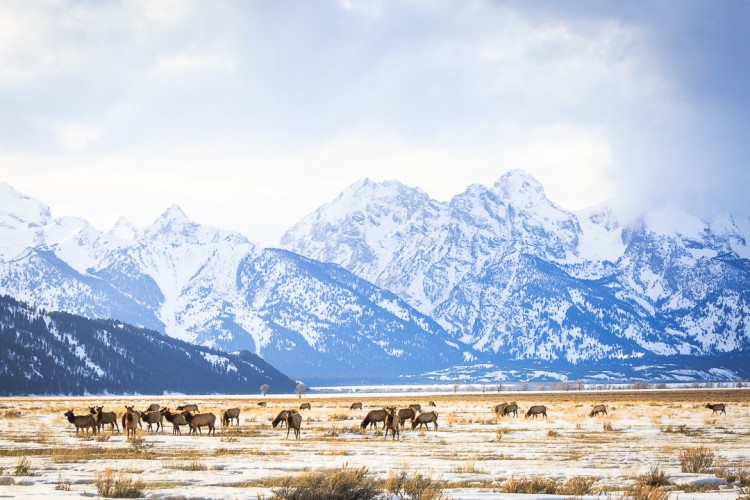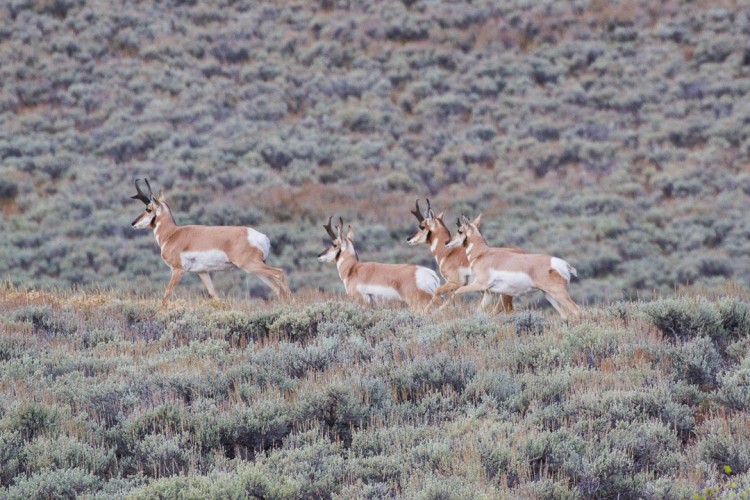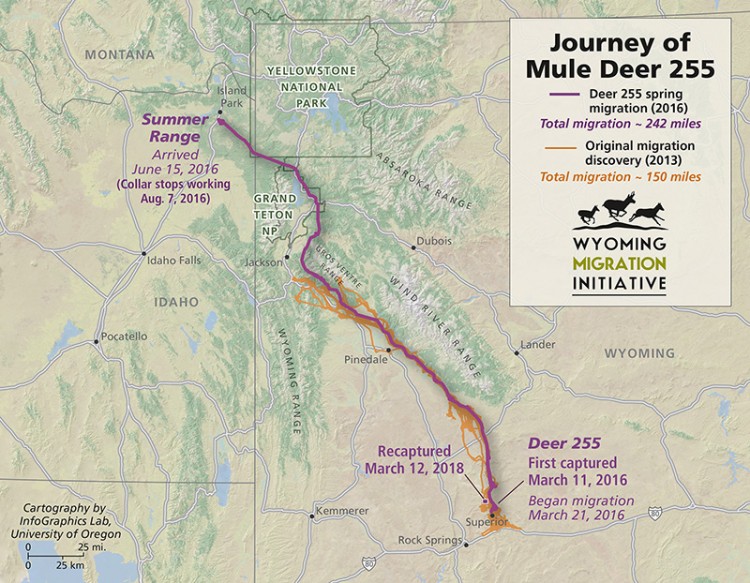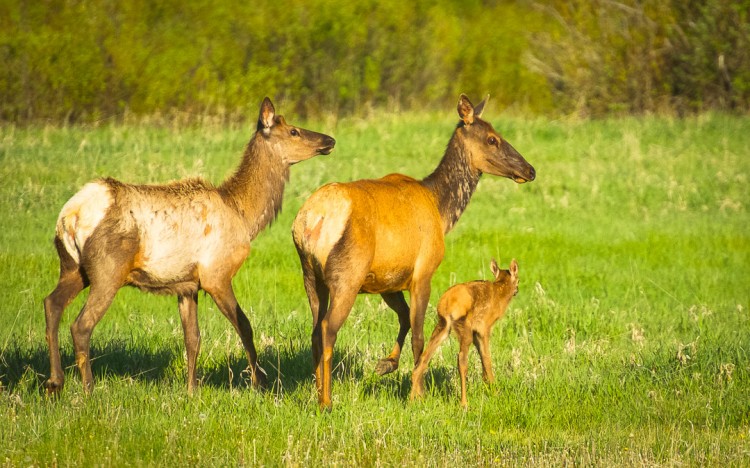Wyoming’s Mammal Migrations Break Long Distance Records


A stunning transformation is beginning to sweep over the Greater Yellowstone Ecosystem (GYE). For months, our great herds of elk, deer, pronghorn, moose, bison, and bighorn sheep have taken shelter in valleys, retreating from the snow covered mountains. Now, the melting snow exposes hints of green grasses as the region begins to awaken from winters slumber. This is what the herds have been waiting for.
I’m stopped along a road in Grand Teton National Park, watching a herd of several hundred elk run across the road. My guests, heads popped out of the roof hatches of our EcoTour Adventures vehicle watch the powerful spectacle in awe. Migration, happening right in front of our eyes.
All across the Greater Yellowstone Ecosystem, rivers of tens of thousands of animals are now flowing out of the regions valleys, following a wave of greening vegetation into the mountains. By migrating, animals can access the best quality forage as it emerges across the landscape, an ancient strategy which has enabled them to thrive across the GYE. But many of these migrations may be at risk, and without help could be lost forever.
6000 years of Pronghorn Migrations
Travel across the windswept “sagebrush sea” of the state of Wyoming and you will inevitably spot North America’s fastest land animal, the Pronghorn. A relic of the Pleistocene ice age, pronghorn still possess the superior eyesight and speed they used to evade their now extinct predator, the North American Cheetah.
Though their primary predator is now extinct, pronghorn still must migrate to survive winter in Wyoming. And they do so in spectacular fashion. At 100 miles long, the federally protected “Path of the Pronghorn” takes pronghorn from now protected summer range in Grand Teton National Park, all the way south to the Upper Green River where they are currently wintering.

Herds of pregnant does will soon return along this route, arriving in the Jackson Hole Valley beneath the Teton Range in early summer, just in time to fawn. Many will cross specially designed overpasses along HWY 89/191 at Trappers Point, guided to the structures by fences which keep them off the road. Underpasses, preferred by other animals like mule deer, complete the wildlife corridor. And it is working. Since the completion of construction, the area has seen a decline in wildlife-vehicle collisions by close to 80%, a win for wildlife and humans alike.
Marathon Migrations: Mule Deer go the Distance Across Wyoming.
For years, the “Path of the Pronghorn” has been touted as one of the longest migrations in the Americas, second only to a caribou migration in the Arctic. But Wyoming, and the wild country of the western United States hold more spectacular migrations, hidden in plain view.
Rewind back to summer of 2016 in Grand Teton National Park. I watch a mule deer doe cross the road near Jackson Lake, heading north. Where did she come from? Perhaps she wintered on the buttes above Jackson, traveling only a short distance to the southern end of the valley. Or maybe she headed northeast through the Teton Wilderness, arriving on a private ranch in the upper Shoshone River basin. Deer Collared by GTNP biologists have done both.

A collared mule deer doe and fawn nurses in Grand Teton National Park. GPS collar data from deer in the park has unveiled their migrations into Idaho to the West, nearly 100 miles northeast to ranches along the South and North Fork Shoshone Rivers, and south to the buttes above the town of Jackson
I like to think she is a relative and fellow ultra marathoner of 255, a doe collared by the Wyoming Migration Initiative in spring of 2016. 255 belongs to a herd of deer who migrate along the Red Desert to Hoback migration route, a recently discovered 150 mile long route which crosses the state.
In spring most deer in the RDH head north from winter range near Interstate 80. They pause to browse on greening vegetation along the Wind River Range before arriving on summer habitat in the mountains above the Hoback River, just south of Jackson Hole.
255 had other ideas. She continued north, climbing over the Gros Ventre Mountains and dropping into Northern Grand Teton where she would walk the entire length of Jackson Lake. At its northern end 255 crossed, leaving the park and eventually settling down for the summer in Island Park, Idaho.
In the end she had traveled close to 250 miles, an incredible distance close to 100 miles longer than any other known Migration in Wyoming. But would she return in the fall or was this movement just a fluke? Biologists would have to wait, as her collar failed and she disappeared for two years.
For wildlife biologists in Wyoming, March represents a flurry of activity, as crews travel across the state capturing and collaring animals to study their migrations. Using helicopters, deer are netted and brought to waiting biologists who quickly take measurements and fit the deer with new collars to track their movements before releasing them unharmed. One of the deer carried with it an old, non functioning collar. After two years, 255 had been found, alive and well.

The return of 255 to the Red Desert confirms the success of what is now the longest mule deer migration in America.. Ultra Migrations like this one make us rethink what it means to be a mule deer in the west. These tenacious animals are willing to go the distance to maximize their chances of survival, whether navigating hundreds of fences, avoiding cars while crossing busy highways, or squeezing through small pinch points adjacent developments.
Protecting Migration Routes
Though corridors like the Path of the Pronghorn and RDH mule deer migration are being conserved there is much more to be done. Last year EcoTour Adventures joined a coalition of conservation organizations and local citizens alike and successfully passed a $10 million dollar Wildlife Crossings Ballot initiative in Teton County, WY. This funding will help secure under and overpasses in high risk areas where wildlife must navigate our roads. Additionally, Ecotour Adventures is proud to be the first wildlife tour company to have Wildlife Crossings License Plates on all of our vehicles. The funds raised from this project go directly towards mitigating highway impacts on migrating wildlife. We look forward to seeing what else we can do for Wyoming's great mammal migrations.
Preserving America’s Last Great Migrations
I’m back in Grand Teton National Park, watching the herd of elk cross the road when a calf, nearly across the road, slips and falls. She regains her footing, racing back across the road with her startled herd. The elk rest, unsure of what to do, then head back towards the road. A lead female slowly moves across, and the herd follows, increasing in speed as they follow her lead.

This ancient knowledge, this culture, is not only what makes the Greater Yellowstone Ecosystem so special, but is central to its existence. As “the lifeblood of the Greater Yellowstone Ecosystem” to quote biologist Arthur Middleton, migrations quite literally move nutrients across the landscape. They fertilize the soils and sustain our apex predators including mountain lions, grizzly bears, and wolves. The predators in turn feed scavengers, including bald and golden eagles, foxes, coyotes, and even small songbirds.
Migrations are also intertwined in western culture; today wildlife related economic activity (wildlife watching, hunting, and fishing) in Wyoming alone accounts for over $788 million in spending annually.
But most importantly, they connect us across the landscape and are a reminder of our wild past. May they forever persist into the future.
Josh Metten is a Professional Naturalist with Jackson Hole EcoTour Adventures
Now in our 12th year of operation, Jackson Hole Ecotour Adventures leads half day, full day, and multi day wildlife safaris in Grand Teton and Yellowstone National Parks 365 days a year. Let us help maximize your Jackson Hole Experience Today! www.jhecotouradventures.com 307-690-9533 or info@jhecotouradventures.com













